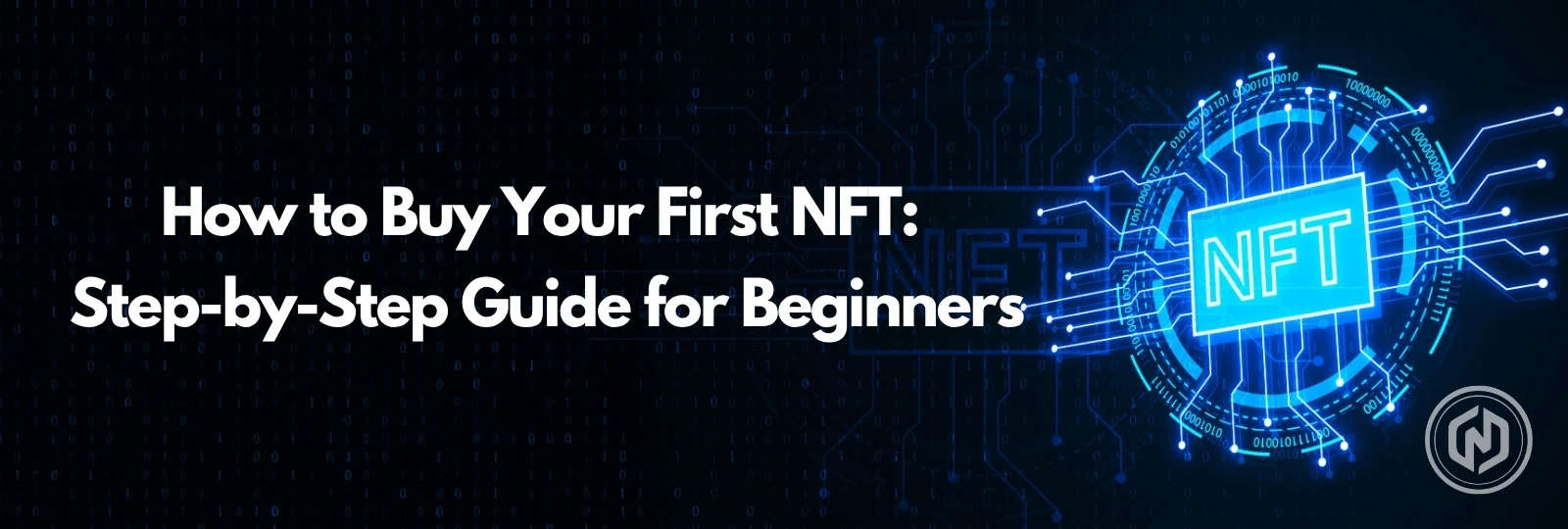The world of digital assets is rapidly transforming and evolving, and NFTs (Non-Fungible Tokens) came out to be the centerpiece of this digital revolution. Whether it is digital art, music, or virtual real estate, NFTs have made it possible to safely own, sell, and trade one-of-a-kind digital assets on the blockchain.
If you are brand new to this space and have no clue how to buy your first NFT or just simply need a bit more comprehensive step-by-step plan on how to do so, you are at the right place. This guide will take you through the entire process of owning an NFT and will also help you understand what NFTs are and how easily you can own them.
What is an NFT?
NFT is an abbreviation of Non-Fungible Token. NFT is a unique digital asset- essentially a digital certificate of ownership of things that live on the internet. NFT is said to be a unique form of digital asset because of the metadata and the token ID that is stored on the blockchain. No two NFTs share the same digital fingerprint.
NFTs may be used to denote:
- Digital art
- Music
- Virtual real estate
- In-game items
- Collectibles
- Memberships and tickets
Ethereum is the preferred blockchain for creating and building NFTs, but in today’s time, blockchains such as Solana, Polygon, BNB Chain, and others also support NFTs and their marketplace.
Step 1: Educate Yourself Before Buying
Before you invest in any form of digital assets, it is important that you understand the basic fundamentals. In the case of NFTs, it is important to understand fundamentals of NFTs, blockchain, and digital ownership.
Know the Risks and the Rewards
It is essential to figure out the good and the bad before investing in any digital asset. For NFTs, we have listed down a few risks and rewards:
Risks include:
- Volatility: Prices may plummet or soar suddenly without any prior warning.
- Scams and frauds: Not every project is legitimate. Some of them are just poorly managed, while others are just scams.
- Limited Utility: Some of the NFTs are just collectible and do not hold a real-world application or resale value.
Rewards include:
- True Ownership: NFTs give you verified ownership over a digital asset, which is backed by the blockchain.
- Rising Value: Certain NFTs have appreciated in value over time. This usually includes rare or early-edition items.
- Utility and Access: Many NFTs now offer benefits such as exclusive content access, in-game perks, access to events, and more.
Follow Credible Resources
- Websites: You can refer to well-known publications such as CoinDesk, CoinTelegraph, NFT Now, and Bankless.
- YouTube Channels: You can refer to YT channels such as Zeneca, GaryVee, and Whiteboard Crypto.
- Communities: Refer to social media platforms such as Twitter (Crypto Twitter), Discord, Reddit r/NFT.
It is important that you refer to reliable and credible sources for any kind of information spread on the internet. This will help you stay updated and will also save you from any kind of scam.
Step 2: Choose the Right Blockchain and NFT Marketplace
Not every NFT is minted or sold using the same blockchain- your experience and costs will differ contingent on which platform you use.
The vast majority of NFTs are minted and traded on Ethereum; however, depending on your budget and interest, you may want to check:
Ethereum
- The most popular blockchain to store NFTs.
- Enormous collection of creators and assortments.
- Transaction fees are high, but the blockchain provides a strong ecosystem.
- Famous marketplaces include platforms such as OpenSea, Rarible, and Foundation.
Solana
- Well-known for speedy transactions and very low fees.
- Very convenient for pocket-conscious customers.
- Famous marketplaces include platforms such as Magic Eden and Solanart.
Polygon
- A scaling solution that provides green and affordable transactions.
- Reduces gas costs and carbon emissions.
- Traded marketplaces include platforms such as OpenSea (Polygon edition).
Tezos
- Popular among self-sufficient and environment-conscious digital artists.
- Provides low minting and transaction fees.
- Famous marketplaces include platforms such as objkt.com, fxhash.
The blockchain that you choose is important as it will determine the transaction costs and the type of wallet that is needed for buying, selling, or trading of NFTs. To do so, you will have to study which wallet supports which blockchain before minting, purchasing, or selling NFTs.
Step 3: Set Up a Crypto Wallet
It is important that you have a secure crypto wallet to buy, store, and sell NFTs or to access a blockchain marketplace. The most common type is called a non-custodial wallet, where you have full control of your keys and assets.
Recommended Wallets:
| Wallet | Supported Blockchains |
| MetaMask | Ethereum, Polygon, BNB Chain, etc. |
| Phantom | Solana |
| Trust Wallet | Multi-chain (Ethereum, Solana, etc.) |
| Coinbase Wallet | Ethereum, Polygon, Solana, etc. |
👉🏻Pro Tip: You are always advised to write your seed phrases on a piece of paper and store them somewhere safe offline. Do not put it up on the internet.
Step 4: Buy Cryptocurrency
NFT platforms prefer cryptocurrency, which means NFT platforms do not support fiat currency. So in order to buy an NFT, you need to buy cryptocurrency first. To do so, follow the below mentioned steps below:
Steps to purchasing crypto:
- The first step should be to create an account with a crypto exchange such as Coinbase, Binance, etc. You can select the exchange on the basis of your preferences.
- Make sure you complete the KYC verification process.
- Buy the required cryptocurrency such as ETH/SOL with INR/USD through UPI, net banking, or debit card.
- Move the crypto to your wallet.
Step 5: Choose the Right NFT
The most thrilling step is exploring collections and choosing an NFT to purchase according to your preferences, financial capabilities, and intentions.
Once you have a funded wallet, you can be on the lookout for the type of NFT you would want to buy. NFT could include:
- Art (well-known collectible such as Bored Ape Yacht Club, Azuki)
- Profile Pictures (PFPs)
- Utility NFTs (access to events, courses, memberships)
- Music NFTs
- Gaming Assets (platforms such as Axie Infinity, The Sandbox can be used)
Factors to Consider Before Buying:
- Maker’s reputation (look at the platform’s social media, webpage, earlier creations)
- Community (look out for active Discord/Twitter following)
- Utility and future roadmap (Compare if it is purely an art or if it provides any benefits with it)
- History of transactions (check if the NFT can be resold or liquidated?)
- Scarcity and uniqueness (use websites such as Rarity Sniper or Trait Sniper)
Step 6: Make Your First NFT Purchase
1. Link your wallet
Head over to your preferred NFT marketplace and look for the “Connect Wallet” button. It is usually located on the top right corner of the screen. Select your wallet provider, such as MetaMask, Phantom, or Trust Wallet, and make sure the connection is successful. Also, make sure to check if you are connected to the correct blockchain network.
2. Choose and search for an NFT
Browse the collection of your interest. While you do so, you can have a look at the price of the NFT, its ownership history, its metadata, and any other information such as rarity features or benefits.
3. Buying it
Listings usually come in two forms:
- Fixed price: Select the “Buy” button and then confirm the purchase in your wallet.
- Auction or bid: Make your offer and sit back until the seller makes a move or the auction closes. If your bid is the highest when the time is up, the NFT is yours.
4. Verifying the transaction
You will be asked to confirm the purchase in your wallet. Verify the information and make sure to look at the estimated transaction (gas) fee. After the approval, the NFT will be sent to your wallet.
Tip: It is also important to have some spare crypto to pay the gas fees, particularly when making a purchase on a network such as Ethereum.
Step 7: View Your NFT
After you have purchased your first NFT, you can show it off.
Once your purchase has been successful, you can:
- Access your wallet or profile at the marketplace.
- Your NFT will be displayed in the ‘Collected’ section.
- You may display it in an online gallery (e.g., OnCyber) or make it a profile picture.
Step 8: Keep It Safe
Keeping your digital asset safe is critical, as Web3 does not include customer support in case you lose your access. In Web3, security is of utmost importance. To secure your NFTs:
Do:
- For high-value NFTs, it is recommended to use a hardware wallet (Ledger, Trezor).
- Mint new or risky projects with a burner wallet.
- To prevent phishing, bookmark official sites.
Don’t:
- Do not provide your seed phrase to anybody. Try to keep it safe offline and not online.
- Stay away from phony links or unfamiliar DApps.
- Do not be tricked by the “free NFT” schemes on Twitter or Discord.
Final Thoughts
Although the process of purchasing your first NFT may look complicated at first but once you break it down into simple steps, you realize that it is fairly an easy process.
With proper research about wallet configuration and marketplace investigation, you will be able to own your unique collectible and potentially valuable digital assets.
Read more: Bityard Review – Trade With Ease!



